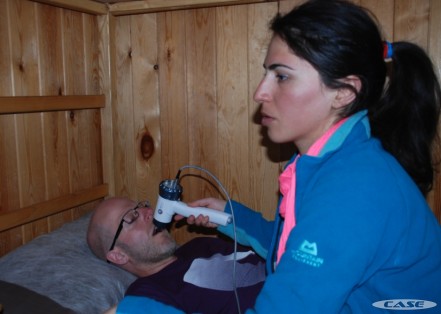Microcirculation analysis using SDF at altitude
One of the many techniques being used on the Xtreme Alps expedition is sidestream dark-field (SDF) imaging. This non-invasive method of visualising the microcirculation was also used by the Caudwell Xtreme Everest team on Cho Oyu and Mount Everest. The SDF camera allows the user to see blood flowing through capillaries, arterioles and venules underneath the tongue. Films are made of the blood flow which are later analysed. On Everest we found that with prolonged time at high altitude the flow of blood through capillaries declined. On this expedition we are looking to see if the nitrate supplementation drink that the subjects are taking has any effect on capillary blood flow at altitude.
The microcirculation is the part of our circulatory system where gases (including oxygen) and nutrients are transferred to the tissues they pass through. Organs therefore depend upon a normally functioning microcirculation in order to work properly. Our interest in the microcirculation stems from the fact that blood flow within it is severely disrupted in critically ill patients. The more disruption that is observed within the microcirculation of these patients, the worse their outcome clinically. So in patients, an abnormal microcirculation appears to be disadvantageous.
Maryam and Jildou have been using the SDF camera at the Margherita Hut, which involves holding the probe underneath the subject?s tongue for several minutes at a time. The technique is all the more difficult at altitude as holding the camera, and your tongue, still, can be quite challenging. |



